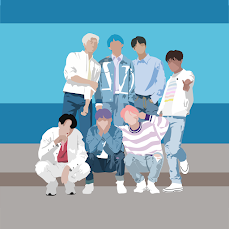- Get link
- X
- Other Apps
- Get link
- X
- Other Apps
Since their debut in 2013, BTS has become a global sensation. Their music, performances, and personalities have captured the hearts of millions of fans around the world. As their popularity has grown, the group has gained a significant following in both Korea and the United States. While BTS remains the same group no matter where they go, there are some notable differences in the way they are perceived and received in these two countries. In this article, we will explore some of the key differences between BTS in the US and BTS in Korea.
Music Style
One of the most obvious differences between BTS in the US and BTS in Korea is their music style. While BTS's music has always been influenced by hip-hop and R&B, their earlier works were more focused on rap and hip-hop, while their more recent albums have incorporated more diverse genres. However, the music they release in Korea versus the US can differ significantly. For example, their Korean releases tend to be more focused on their signature hip-hop sound, while their English-language releases often incorporate more pop and dance elements.
Fan Culture
Another key difference between BTS in the US and BTS in Korea is fan culture. While BTS has a massive fan following in both countries, the way fans engage with the group is different. In Korea, fans tend to be more reserved and respectful towards idols, while in the US, fans tend to be more vocal and expressive. This can be seen in the way fans interact with the group at concerts, fan meets, and other events. In Korea, fans often show their support by waving light sticks and singing along, while in the US, fans tend to be more physical, with crowd-surfing and mosh pits being common at concerts.
Marketing and Promotion
The way BTS is marketed and promoted in the US versus Korea is also different. In Korea, the group is heavily promoted through television appearances, radio shows, and variety programs. They also often participate in Korean music shows, where they compete against other K-pop groups for music show wins. In contrast, BTS's success in the US has largely been driven by social media, particularly Twitter and Instagram. The group's presence on these platforms has allowed them to connect with fans directly and build a strong online following.
Language and Cultural Differences
BTS's success in the US has also brought attention to some of the cultural and language differences between Korea and the US. While the group has made efforts to bridge these differences, there are still some challenges that they face. For example, the members have had to adjust to speaking English during interviews and appearances in the US, which can be difficult for those who are not fluent. Additionally, there are some cultural differences that can be challenging to navigate, such as differences in humor and social norms.
Receptions from Media
The way that BTS is received by the media in the US and Korea is also different. In Korea, BTS is seen as a cultural icon and a source of pride for the country. They are often praised for their achievements and contributions to Korean music and culture. In the US, BTS has received mixed reactions from the media. While they have been praised for their music and performances, they have also faced criticism and skepticism from some media outlets.
Conclusion
In conclusion, while BTS remains the same group no matter where they go, there are notable differences in the way they are perceived and received in the US and Korea. These differences are shaped by a variety of factors, including music style, fan culture, marketing and promotion, language and cultural differences, and media reception. Ultimately, these differences highlight the unique challenges and opportunities that BTS faces as they continue to navigate the global music industry.
Achievements
BTS
Contributions
CulturalDifferences
dance
FanCulture
HipHop
Interviews
Korea
Language
Marketing
Media
Music
Pop
promotion
Reception
RnB
SocialMedia
US
VarietyPrograms
- Get link
- X
- Other Apps
